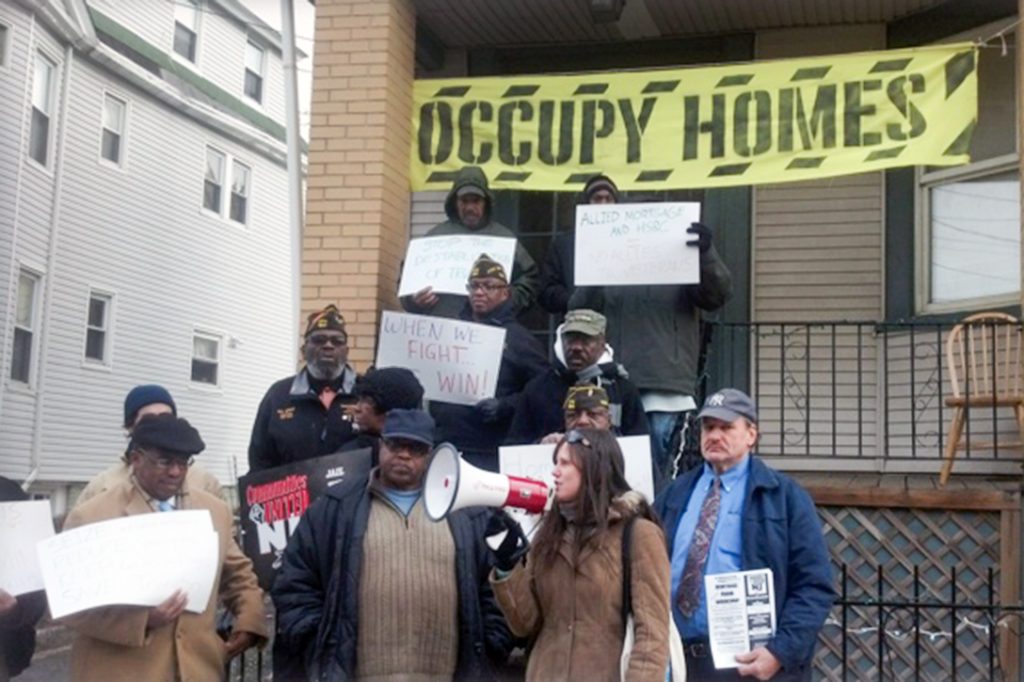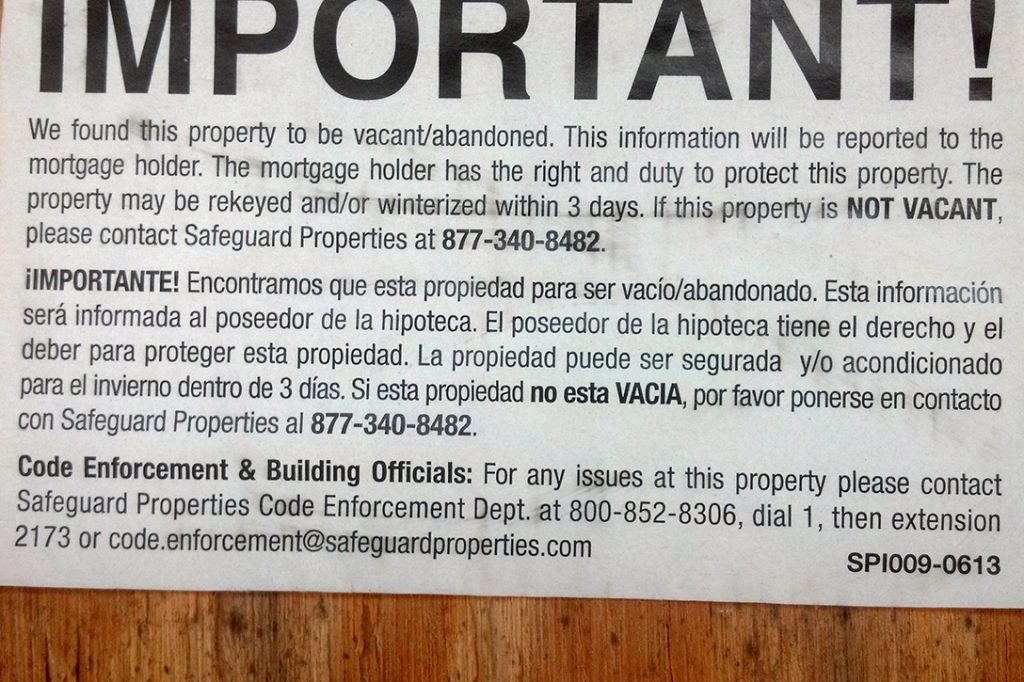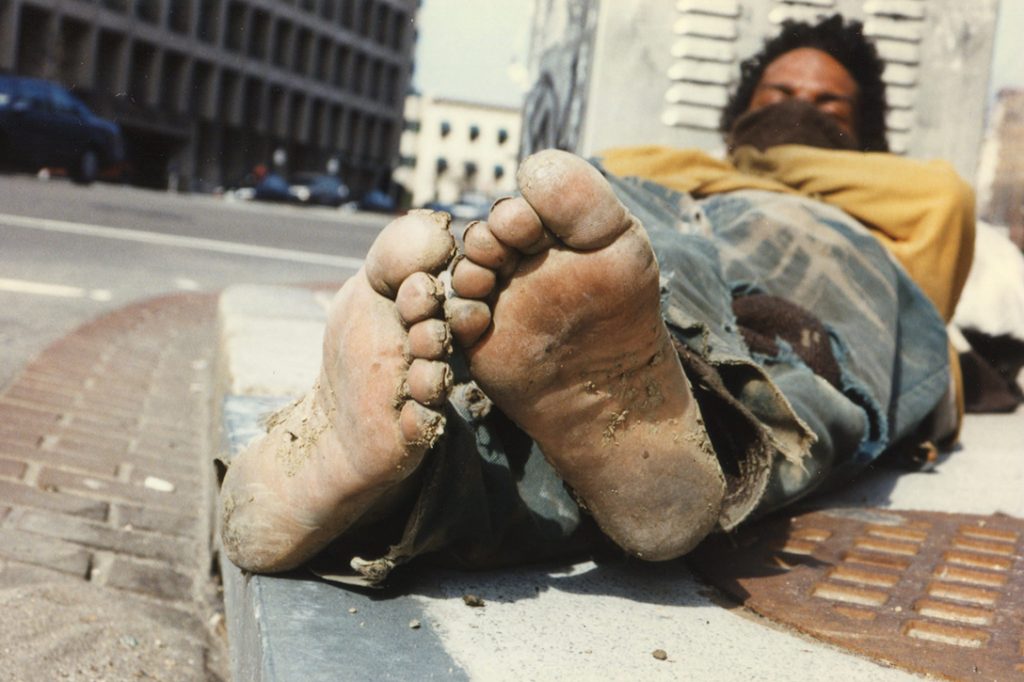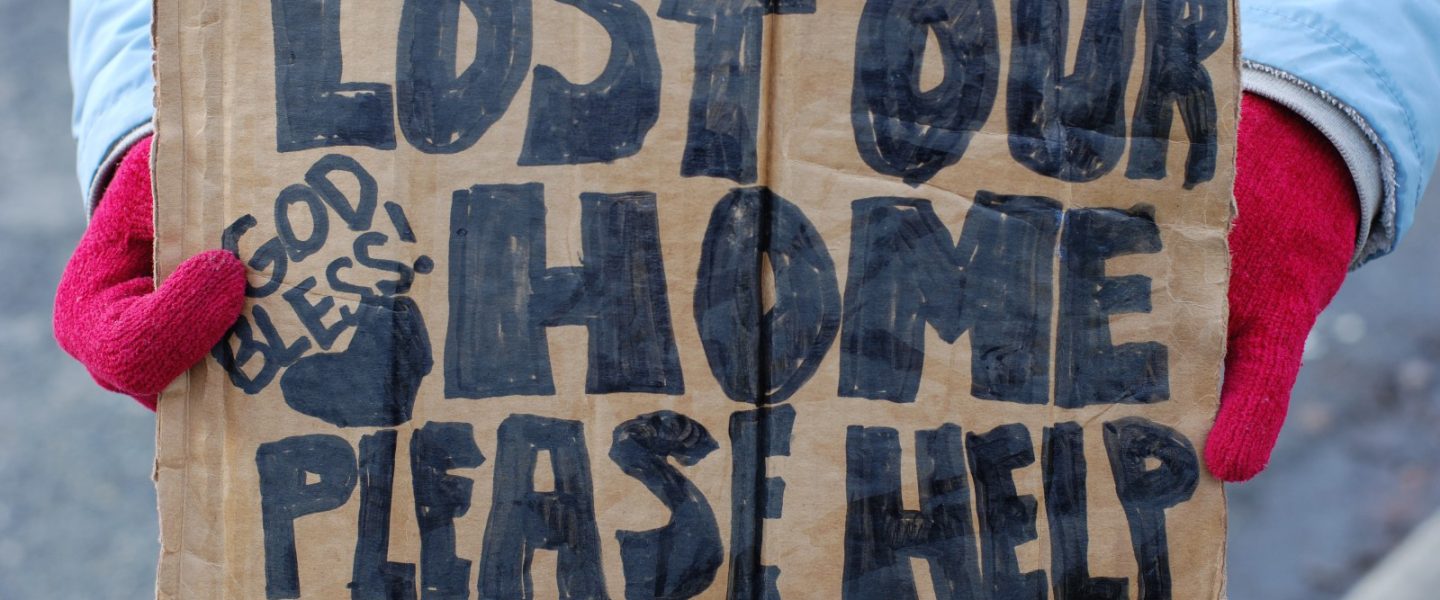Millions of Americans are living in poverty or paycheck to paycheck; they are homeless, undergoing eviction, or are burdened with underwater mortgages. Why does the “recovery” look so hopeless?
Throughout the 2016 presidential campaign, Donald Trump made huge promises to rebuild America’s infrastructure, while Hillary Clinton promised to preserve the middle class. Yet neither of them addressed the nation’s homelessness and housing affordability crisis, which has been getting worse since the 1970s and has only accelerated in the years since the Great Recession of 2008.
The complete absence of this issue from the 2016 campaign underlines how our multi-billion dollar electoral extravaganza remains wholly disconnected from the actual conditions that tens of millions of Americans find themselves in.
No wonder voter turnout hit a 20-year low in 2016. For all of the hype, the American political conversation has focused on everything but the plight of one-third of the nation — the segment of the population that either never made it into the middle class, or fell out.
Historically, both Democrats and Republicans embraced home ownership as the panacea that would put every family on the path to wealth accumulation and stability. But in the aftermath of the the Wall Street-enabled housing crash, which cost American families up to $20 trillion dollars in lost household wealth, neither party dared to float a plan B. Meanwhile, the banks got bailed out while local governments in the top 25 hardest-hit communities were left with 2.5 million vacant housing units, according to a 2014 report from HUD.
For the several million Americans who lost their homes to foreclosure the consequences will be generational. But for the likes of Goldman Sachs and Moody’s Corp, all it took to get free and cleared for their role in precipitating the collapse of the American real estate market was their ability to write the Obama administration a check for $5 billion in the case of the Wall Street bank and $864 million in the case of the rating agency.
Back in 2014 in an obscure speech at the Vatican, Stephen Bannon, Trump’s top campaign strategist and now the president’s senior counselor, told the Human Dignity Institute, a Catholic linked NGO, that the fact that “not one criminal charge” had ever been brought against any “bank executive associated with the 2008 crisis” was part of “the fuel of this populist revolt that we’re seeing as the tea party.” Bannon, a former employee of Goldman Sachs, told the audience that the financial crisis was “driven by the greed of the investment banks.”
No doubt, the anger of that part of the electorate that was caught up in the post 2008 downward migration, driven by an unprecedented loss in household wealth, had everything to do with Trump’s ability to flip more than 200 counties in places like Pennsylvania, Ohio and Michigan. Those same counties were the very ones that did not bounce back from the meltdown but had voted twice for Barack Obama in 2008 and 2012. It was this same resentment over the actual decline of the middle class in these places that was a key part of Senator Bernie Sanders’s (I-VT) energetic but unsuccessful campaign.
“Somebody decided someone had to take a loss on the massive fraud behind the mortgage backed securities and it was decided in Washington it would be the homeowners because the banks and the mortgage servicers owned the White House, the Treasury, the state houses, Congress and the courts.” — Laura Walsh
Yet, since President Trump’s victory, it has been hard to decipher just what remedy the new administration has to right the injustice that Bannon had flagged in his 2014 Vatican speech. Trump has tapped several top Goldman Sachs veterans for key government posts, including Steven Mnuchin as Treasury Secretary. Back in 2011, 100 demonstrators marched on his $26 million dollar Bel Air mansion to protest his OneWest Bank’s foreclosure practices. Those practices got him in hot water with both state and federal regulators, resulting in a consent decree with the Office of Thrift Supervision.
The appointment of Dr. Ben Carson, a retired neurosurgeon with absolutely no housing policy background, as the head of the Department of Housing and Urban Development (HUD), along with the GOP’s long-standing hostility to funding the agency, has housing advocates fearing an already failing safety net could completely unravel.
At Carson’s confirmation hearing earlier this month, the former presidential hopeful recounted his own childhood experience of being brought up in poverty in Detroit and feeling “housing insecurity” first hand when he had “nowhere to live” after his parents divorced, forcing him and his mother to double up with relatives in Boston.
He described his own frustration in his role as a pediatrician working to heal children in East Baltimore only to see them return to unsafe housing conditions that included exposure to lead, known to cause severe brain damage.
Ranking Senate Banking Committee member Sen. Sherrod Brown (D-OH) told the HUD nominee that, based on the most recent data, 11.5 million American households were spending more than half their income on rent. Carson conceded that “was unacceptable” and committed to go on a national listening tour as well as to make an effort to seek out the advice of veteran career HUD officials.
Carson won the support of all the Republicans on the committee as well as the votes of Democrats Brown and Sen. Elizabeth Warren (MA). His nomination now heads to the full Senate where his confirmation is expected.

But while Carson is getting his bearings, the housing crisis continues to take a toll on the most vulnerable. A 2016 press release from the US Department of Education advised the nation’s public schools that, based on their latest available data, at least 1.3 million school-age children in the US were homeless. The Washington Post had reported in 2015 that the number of homeless children was close to double the number of kids without a fixed address in the 2006/07 school year.
“Research shows that these students experience significant academic, social, and socio-emotional challenges, and that being homeless is associated with lower school achievement and increased risk of dropping out of school,” a US Department of Education advisory warned. The federal advisory was part of an expansion of the Every Student Succeeds Act. Yet this troubling trend was ignored during the 2016 campaign.
Slide Decades in the Making
This issue of homelessness and housing affordability has been with us for decades. “The first sign of modern homelessness in New York City was the appearance of thousands of homeless men sleeping in parks, on sidewalks, in transportation terminals, and in other public spaces in the late 1970s,” according to the Coalition for the Homeless website. Scroll forward a few decades and that unsheltered cohort includes children, elderly women and entire families.
The 70s also marked the beginning of the great unraveling of the middle class that has only accelerated since, creating an ever widening income and wealth disparity that is particularly pronounced in New York. That’s when American workers stopped seeing their wages grow along with their increasing productivity. Last summer the Economic Policy Institute reported that from 1973 until last year, while productivity had increased by over 73 percent, actual hourly pay for workers had only gone up by 11 percent — or more precisely, productivity had grown by more than six times the wages earned by workers.
It appears that going back to the 1970’s we see a handful of insightful authors who offered an unflinching eye on this underside of America in a valiant, if not vain attempt, to prick what appears to be a shrinking national conscience.
For decades, educator and activist Jonathan Kozol has chronicled the voice of children and families who struggle for the basics like shelter. Kozol writes that Americans are advised that helping homeless children makes financial sense because it will end up being more expensive not to address the problem.
But in his book, Ordinary Resurrections, Kozol challenges us. “Why do our natural compassion and religious inclinations need to find a surrogate in dollar savings to be voiced or acted on? Why not give these kids the best we have because we are a wealthy nation and they are children and deserve to have some fun while they are still less than four feet high?”
The evidence is clear and convincing that the existing, decades-old federal poverty formula is outdated, failing to account for child care, the dramatic increase in housing costs, and the wide disparity in these costs between regions.
The long-term socio-economic consequences for homeless children and society as a whole are immense, according to Dr. Harriet Fraad. His family therapy practice focuses on helping families cope with the psychological impact of economic dislocation, a trend she believes defines the post crisis years for so many households.
“For homeless children everything is floating because they have no foundation and not having a safe home is terrifying,” said Fraad who has worked with homeless families and children in New Haven. “They are at the mercy of whatever cruelty there is on the street. Parents often have to sedate these children in order to beg with them on the street.”
“You really have to embrace these young families because that newborn to two-year-old time period are the prime years for brain development and the infant to age six are the years of genius when children can learn whole ways of creatively thinking without explicit instruction,” said Fraad. “We are real outliers on this when you look at our ranking amongst the Organization for Economic Cooperation nations and even the UNICEF rankings on child well being.”
The Violence of Eviction
During the 2016 presidential campaign, The New York Times flagged the fact that both Clinton and Trump were largely ignoring one of the nation’s most pressing issues when it quoted Matthew Desmond, a Harvard professor of sociology. “We don’t have a full-voiced condemnation of the level or extent of poverty in America today,” Desmond told the Times. “We aren’t having in our presidential debate right now a serious conversation about the fact that we are the richest democracy in the world, with the most poverty. It should be at the very top of the agenda.”
Desmond’s book “Evicted-Poverty and Profit In the American City” raises the curtain on an enduring legacy of the Great Recession largely ignored by the corporate news media. Millions of Americans, including infants and the elderly, are evicted from their homes every year because they can’t afford their rent. In a city like Milwaukee, Desmond found that out of a universe of 105,000 renting households, 16,000 adults and children were thrown out on the street every year.
This latest United Way data shows that for the city’s five boroughs the combined categories of those living below poverty or living check to check account for 71 percent of households in the Bronx, 56 percent in Brooklyn, 50 percent in Queens, 42 percent in Staten Island and 35 percent in Manhattan.
“Families have watched their incomes stagnate, or even fall, while their housing costs have soared,” writes Desmond. “Today the majority of poor renting families in America spend half of their income on housing, and at least one in four over 70 percent to paying rent and keeping the lights on.”
The State of the Nation’s Housing Report that Senator Brown cited at Carson’s confirmation hearing also found that across the country there was only sufficient housing units to shelter less than one in three of low income families. Between 1980 to 2014 the income for the bottom tenth of the country was down by 18 percent, from $7,700 to $6,300, while the top earners saw a 66 percent upside, going from $154,000 to $256,000 over the same period.
Obama — Banks over Neighborhoods
While the housing affordability crisis had been percolating for decades, the 2008 foreclosure meltdown made matters far worse.
“Somebody decided someone had to take a loss on the massive fraud behind the mortgage backed securities and it was decided in Washington it would be the homeowners because the banks and the mortgage servicers owned the White House, the Treasury, the state houses, Congress and the courts,” said Laura Walsh, an anti-foreclosure counselor who has worked with hundreds of families trying to keep their homes.
According to Kathleen Engel, professor of law at Suffolk University in Boston, the way the Obama administration handled the foreclosure crisis exacted too heavy a toll on local communities and made the affordability crisis even worse. The banks and mortgage service companies profited from the federal government’s rush to sell off problem mortgages rather than work with homeowners even as the foreclosure crisis continued.
“As of 2016, over 6 million homes have gone into foreclosure, 400,000 homes are in the process of being foreclosed upon, almost 1.2 million mortgage loans are seriously delinquent, and 3.2 million homeowners are underwater,” writes Engel, who with Patricia McCoy co-authored Subprime Virus. “Plus, there is still a backlog of homes that are slated for foreclosure. As evidence of this, in 20 states, the number of foreclosure “starts” has increased from a year ago.”

“Some of the ways the federal government handled loans in default actually exacerbated the distress in blighted communities. For example, in order to replenish funds in the Federal Housing Administration insurance program, HUD decided to sell Federal Housing Administration-insured loans that were in default to the highest bidders, primarily private equity firms. The problem with this approach is that private equity firms had no interest or expertise in stabilizing neighborhoods.”
And so post-Great Recession, despite some aggregate data that shows lower unemployment and dips in poverty, the crisis in affordability continues to pull more and more American families under. Consider the work of the United Way’s ALICE (Asset Limited, Income Constrained, Employed) project. ALICE tracks the growing number of Americans in several states who live above the poverty line, are working, but still struggle to cover the basics, paycheck to paycheck.
In contrast to the federal definition of poverty, the ALICE matrix includes what it costs locally to find housing, buy food, use transportation, provide child care, access health care and pay taxes. These numbers can vary widely, even within the same state. The United Way-sponsored project has now conducted comprehensive research in California, Connecticut, Florida, Indiana, Michigan, New Jersey, Idaho, Oregon and Washington. Studies are pending for Iowa and New York.
The evidence is clear and convincing that the existing, decades-old federal poverty formula is outdated, failing to account for child care, the dramatic increase in housing costs, and the wide disparity in these costs between regions.
In California, 46 percent of families fell below the ALICE affordability threshold, followed by Florida at 45 percent, Michigan’s 40 percent, Indiana’s 37 percent and Connecticut’s 35 percent. In some cities within Connecticut, more than 60 percent of families fell below the threshold.
According to a six-state comparative analysis, “the growth of lower-skill jobs is projected to outpace that of medium and high-skilled jobs into the next decade in all six states” even as “cost of basic household necessities continues to rise.”
According to data just released in New York, 44 percent of the Empire State’s households either are living below the established poverty line or are in this marginal ALICE cohort, living paycheck to paycheck. In the five boroughs of the city, the data is even more alarming and paints a picture of a 21st century feudalism with a perilous tipping point.
This latest United Way data shows that for the city’s five boroughs the combined categories of those living below poverty or living check to check account for 71 percent of households in the Bronx, 56 percent in Brooklyn, 50 percent in Queens, 42 percent in Staten Island and 35 percent in Manhattan. It should come as no surprise that New York City represents the widest contrast between counties in terms of wealth disparity in the state.
In the aggregate in New York City, the United Way data indicates that 51 percent of the households are either living in poverty (20 percent) or are in the struggling ALICE category (31 percent). In Buffalo, Rochester, Schenectady, Syracuse, and Utica over 60 percent fall into these struggling cohorts. For these families, ever-rising rents exact a heavy price.
The crunch between income and the cost of shelter is one of the prime drivers behind New York City’s homeless crisis where close to 65,000 people are homeless and more than 24,000 of those are children. According to the Institute for Children Poverty and Homelessness, over 116,000 students statewide are homeless.

Meanwhile, news about the deaths among the homeless or mass casualty events related to marginal housing stock are reported as local anecdotes. For instance, 36 people were killed in Oakland, California last month when a warehouse that had been pressed into makeshift housing caught fire. The crisis only goes from abstract data to actual body count when the numbers are too large to ignore. Consider the 123 homeless people that died out on the street in Santa Clara County in 2016, twice the number of the year before, according to the Mercury News.
For those on the street now, providing temporary warehousing is a wasteful and ineffective strategy experts say. “Since modern homelessness began more than thirty years ago, research and experience have overwhelmingly shown that investments in permanent housing are extraordinarily effective in reducing homelessness — as well as being cost-effective,” according to the Coalition for the Homeless. “Numerous research studies have consistently confirmed that long term housing assistance not only successfully reduces homelessness — it is also less expensive than shelter and other institutional care.”
Back to the Basics?
Post-2008 foreclosure meltdown, it’s important to know there are alternative models out there for financing housing ownership that strengthen community rather than undermine it.
In a time depicted by Frank Capra’s “It’s A Wonderful Life,” the local savings and loan provided mortgages to the people in the community that it served and that defined it. In essence the bank invested in the family it gave the mortgage to so the family would in turn build a home and in good time pay back the bank, assuring that the bank would have money to issue yet another mortgage to another family. There was no bundling the mortgages and selling them off to some other entity somewhere else.
That sense of community cohesion for banking still exists in the form of the nation’s credit unions. Across the country there are close to 6,000 of them and what makes them so different from the likes of Wells Fargo is that they are nonprofit cooperatives in which depositors are members. Deposits are also federally insured for up to $250,000. Already close to 105 million Americans are credit union members.
Back in the run-up to the 2008 market crash not every financial institution fell for the smooth talking hawkers of the mortgage-backed securities that would prove the undoing of the global economy. Kam Wong, 60, is the president and CEO of New York City’s Municipal Credit Union that serves close to 400,000 mostly public sector workers. When the ‘big-short’ type sales guys called looking to off-load their product, Wong said “no, thanks.”
“We received a lot of cold calls from different brokers asking us to invest in mortgage backed securities, CMOs, collateralized mortgage obligations,” recalled Wong in an interview late last year to mark the 100th anniversary of the credit union. “Well, with my background in finance accounting I asked myself back then ‘why would I buy that paper without knowing what kind of mortgage is in it it. You are talking about one piece of paper being worth $20 million. I just didn’t feel comfortable and I refused to go into that sort of investment.”
But MCU’s decision to take a pass on the ‘toxic assets’ was not the only divergence between the credit union and the rest of the conventional banking sector. From the very beginning of the crisis, the MCU decided to bend over backwards and offer members who were falling behind in their mortgages up to 18 months in loan forbearance.
It was a courageous decision. While the public employees that were MCU members held onto their jobs, their spouses and other family members were at the mercy of a job market where millions of jobs were disappearing. The rapid slide of the real estate market meant that just as was happening everywhere else, the MCU mortgages credit union members held were now for more money than the declining value of their home. That nationwide trend prompted many banks to file for foreclosure, which only accelerated the downward trajectory of housing prices, widening the path of destruction as the market collapsed.
“During the crisis in mortgage loans the price of houses went down so you have the upside down loan situation,” Wong said. “I instituted, with my chief credit officer, a forbearance program for mortgage delinquency in 2008 — that’s before anybody tried to do that.”
As it turned out, MCU’s forbearance program was not just a compassionate gesture, but was an astute business move because by holding off on foreclosure the credit union helped preserve the underlying value of the home and prevent the further erosion of the local neighborhood’s property values. It also kept the member family in their home and helped limit the losses the credit union would have to write down if it had to sell off the house at a firesale price.
“If we foreclose on a property I definitely will lose money because they owe me $400,000 (for the mortgage) and the value of the home is now $200,000 so if I go and sell it in the market I can only recoup half of the value of the mortgage,” Wong said. “Compare that to working with the member and saying ‘your wife lost a job, you have an event that is a financial crisis, it could be temporary — tell you what, don’t pay me for the next six months until your finances change.” Out of the 400 stressed mortgages under MCU management, Wong says the credit union only had to foreclose on less than 10 houses. The MCU currently has a mortgage portfolio worth $600 million, roughly 3,000 home loans.
Trump’s pick for Treasury Secretary Steve Mnuchin has yet to be confirmed. His failure to list $100 million in assets on his disclosure forms and his failure to list his directorship of an investment fund headquartered in the Cayman Islands, a leading tax haven, sparked sharp questioning from Democrats on the Senate Finance Committee.
Trump’s presidency is not yet two weeks old but there are already some troubling signs that the millions of Americans families caught in the rental housing affordability crisis will not see relief anytime soon. Within the first two hours of Trump’s taking the oath of office the federal government reversed an Obama plan to cut the insurance premiums for first time home buyers counting on federally backed mortgages to get their families out of rental housing.
In a statement, the National Association of Realtors wrote that between 750,000 to 850,000 homebuyers would see higher costs with as many as 40,000 families that would have qualified under the Obama proposal, losing their shot at homeownership.
Related front page panorama photo credit: Adapted by WhoWhatWhy from tents (Fabrice Florin / Flickr – CC BY-SA 2.0)



